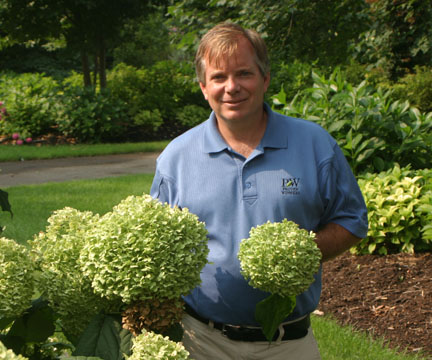 Note from Fran: We’re delighted to have Tim participate in Take 10: Q & A. Tim is the product development manager at Spring Meadow Nursery where his main job is to find and develop new and better flowering shrubs for the North American market. Tim also travels the world to find new plants and work with plant breeders to develop their plants. You can find his blog at The Plant Hunter.
Note from Fran: We’re delighted to have Tim participate in Take 10: Q & A. Tim is the product development manager at Spring Meadow Nursery where his main job is to find and develop new and better flowering shrubs for the North American market. Tim also travels the world to find new plants and work with plant breeders to develop their plants. You can find his blog at The Plant Hunter.
1. What is the one thing that we’d be surprised to learn about you?
Elijah Wood (Frodo the Hobbit) is my cousin.
2. If you weren’t in the world of gardening, what would you be doing?
I would have loved to study literature and be a writer.
3. If you could be a plant in another lifetime, what would it be?
I’d be an American beech tree. They’re beautiful, grand, produce food and shade for the critters, and they’re immortal. Even if the main tree dies, it produces hundreds of root suckers that turn into new trees.
4. If you could create the perfect plant, what would it be?
A spring blooming, pink flowered Clethra. Clethra is such a great plant but because it flowers in late summer few people know it or grow it.
5. Did you know in your teenage years that gardening was going to be your adult work?
I grew up on a nursery and made $0.25 a row hoeing. I hated the hard work, being constantly dirty and being sore, but I loved the plants. I did not intend to work in a nursery, but here I am and I love it. I would have never known that a person could have a job like mine. They never mentioned “Plant Hunter” on career day in highschool.
6. What is your favorite place in the world for finding inspiration or how do you go about finding inspiration in your work?
My favorite place to be is walking the seedling beds where we grow out the plants that resulted from the crosses we’ve made. Each plant is different and before they mature they all have potential. You can grow out 2,500 seedlings and if you find one plant that might end up in someone’s yard or garden. It’s a thrill.
7. What’s the greatest plant expedition you’ve been on?
My travels in South Korea are the most memorable. I documented the trip in an article (you can read it here) and I still get a kick out reading it and recalling all the unusual things we did there.
8. What’s your take on the debate over native plants?
I love native plants and I think that native plants are the right choice for natural landscapes. But I love all plants and I think when we narrow our view based on where the plants are indigenous to at a specific date in history it’s silly and arbitrary. During the Ice Age, there were no native plants in Michigan. We should choose the best plants for the job, particularly in urban settings. It drives me crazy when I read that “Native plants have fewer insect and disease problems, that they are more drought tolerant, or require less care.” Anyone that knows anything about plants knows this is hoowie.
9. Do you think that gardening has become too politically correct?
I think gardeners are under attack. Even public gardens have turned their back on gardening because there’s more grant money and cachet in conservation. And now in this time of Sustainability and Green, the clear need, the necessary message, and the great opportunity being neglected is that plants and gardens need to be at the core of the Green movement. But why plant tree seedlings in a distant forest as carbon offsets when we need to be planting trees, shrubs, perennials in our cities and yards; close to the sources of carbon and pollution, and where people can actually be healed by the power of plants?
I would encourage everyone to champion gardening as a green lifestyle. What a unique time and place we are in to promote the healing power of plants by planting our own yards and neighborhoods! Change happens locally.
10. When you’ve died, what do you want to be remembered for in the world of gardening?
I would love to leave a legacy of having developed and introduced a body of great plants that for years to come bring people joy.
